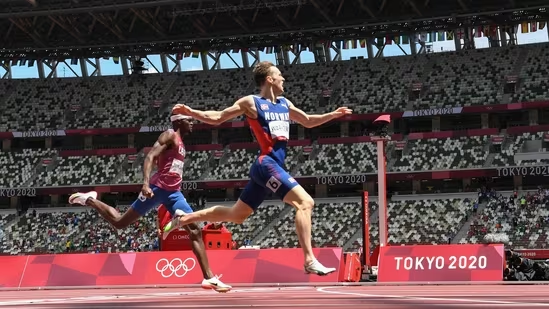How to rule the world, in 13 steps
For the last two years, Norwegian Karsten Warholm and American Rai Benjamin circled each other like two predators tracking the same gazelle. The gazelle, in this case, was the 29-year-old world record in the men’s 400m hurdles. Kevin Young, the owner of the said gazelle, knew it was time – gazelles and world records aren’t meant to last that long. The only question was who would get it.  PREMIUM
PREMIUM
Young was born in 1966 in southern California, and went to Jordan High in Watts, a working-class neighbourhood in Los Angeles. The school, famous for jazz musicians Charles Mingus Jr and Gil Bernal, was starting to gain attention in the 1980s for a different reason – it was where Florence Griffith Joyner ran track.
When Flo-Jo won the 200m silver at the 1984 Olympics, Young was still a 110m hurdler and a triple jumper. By the 1988 Olympics, where she set an Olympic record in the 100m and a world record in the 200m, Young was concentrating on the 400m hurdles – an event in which Edwin Moses had set the gold standard with Olympic golds in 1976 and 1984. (The US boycotted the Moscow Games).
The crux of the event, and Young knew this well, lay in the number of strides taken between each of the 10 hurdles placed evenly around the track. Conventional wisdom recommended taking 14 steps between each jump – 15 all the way was too slow to be competitive, and 13 was considered impossible because the longer stride was too physically taxing to hold for the entire race. To get the most out of their bodies, most athletes would start with 13 strides for the first few hurdles, switch to 14 midway, and then take 15 towards the end as they got tired.
But, in the early 1970s, Moses got obsessed with the idea that smoothness was the key to speed. He wanted to somehow manage an even 13 strides between hurdles through the race – this would ensure the racing rhythm was not broken because he wouldn’t have to switch between legs to jump. The way to achieving that, he concluded, was to train for endurance (1,500m and cross country) as much as for acceleration (100m and 200m).
At Montreal 1976, Moses pulled off a miracle 13-stride run for a world record 47.64 seconds. The 400m hurdles would never be the same. Over the next seven years, he took 153 steps (19 in the 45m lead-up to the first hurdle; 13 each in the nine 35m intervals between the hurdles; and 17 in the 40m between the last hurdle and the tape) in almost every race. He lowered his world mark three more times, bringing it down to 47.02 by the time he got his second Olympic gold in Kevin Young’s hometown of Los Angeles.
ALSO READ | Tokyo Olympics 2020 Full Coverage
It seemed the record was unattainable even as Young tried to find the key that would unlock the secret. He spent months trying to copy the 13-step model but was not able to nail it -- he just didn’t have the stamina. He then started experimenting with different patterns that would better suit his style and physique. Young discovered, to his surprise, that the answer didn’t lie in shorter steps (the theory was to veer towards 14 or 15 strides) but in going longer.
At Barcelona 1992, it all came together. According to an analysis by Steve McGill at hurdlesfirst.com, Young ran the leg before the first hurdle in 20 steps, and then took 13 strides to hurdles 2 and 3, an astonishing 12 strides to hurdles 4 and 5, and back to 13 strides from hurdles 6 to 10.
The result: 46.78 seconds, the first sub-47s in history. In other words, the gazelle that Warholm and Benjamin were chasing.
Last month, the Norwegian successfully hunted it down when he ran 46.70 in Oslo. On Tuesday morning, at Tokyo 2020, he eradicated that record with an astonishing 45.94, the first sub-46s ever recorded. But where does the other predator, Benjamin, fit in this chase? On Tuesday, at the Olympic stadium, he clocked 46.17 for silver -- a time that would’ve smashed Young’s record. For good measure, a third wildcat, Brazil’s Alison dos Santos, ran 46.72 for bronze – which, too, would have broken Young’s record had it still existed.
The fastest time in the world since 1992 until last month is now the fifth fastest, destined to slip further down the pecking order by the time Warholm and Benjamin are done.
Now, if you’re wondering how many strides the Norwegian takes between hurdles: it depends on his mood; he simply doesn’t care. Warholm told Track & Field magazine that he sometimes takes 13 steps all the way; sometimes 13 till hurdle 8 and then 14 for 9 and 10. “I’d been caught up in all these strides… I came to the conclusion that it’s better to just pass the hurdles as they come.”
So, in Tuesday’s race, the greatest ever run, he took 13 strides each till hurdle 9, changed it up to 15 between hurdles 9 and 10, and then “just ran with my life.”
Experience unrestricted digital access with HT Premium
Explore amazing offers on HT + Economist Start 14 Days Free Trial Already Subscribed? Sign In
Disclaimer: The copyright of this article belongs to the original author. Reposting this article is solely for the purpose of information dissemination and does not constitute any investment advice. If there is any infringement, please contact us immediately. We will make corrections or deletions as necessary. Thank you.







